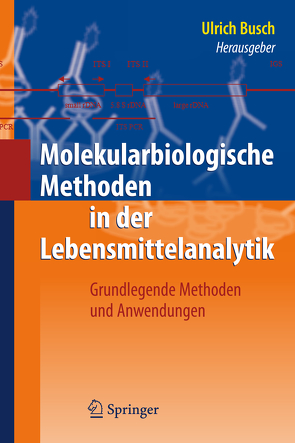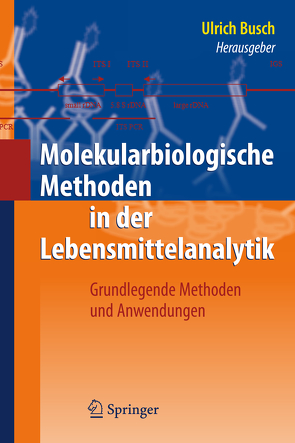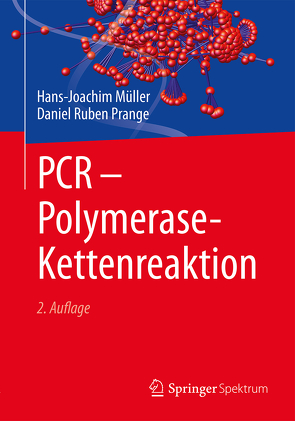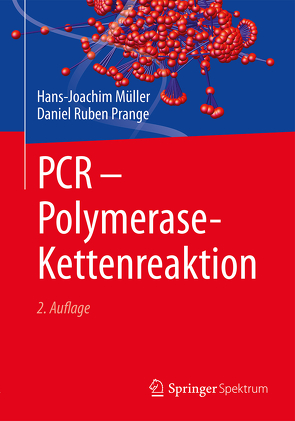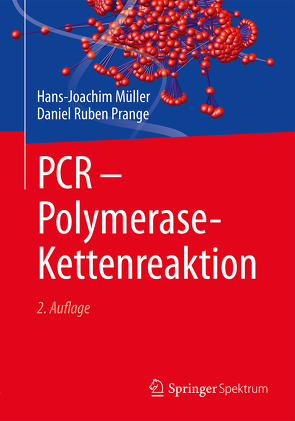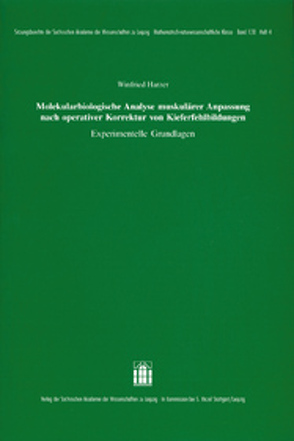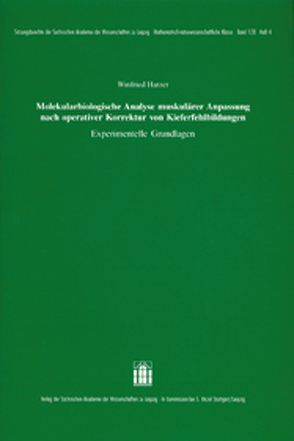Molekularbiologische Verfahren werden seit Längerem in der Analytik von Lebensmitteln, Saatgut und Futtermitteln angewendet. Das Spektrum reicht vom Nachweis gentechnisch veränderter und allergener Inhaltsstoffe über die Tierartendifferenzierung in Fleischprodukten bis zur Bestimmung pathogener Keime. Das Buch vermittelt in äußerst praxisbezogener Weise die notwendigen molekularbiologischen Techniken und das nötige Hintergrundwissen. Einen Schwerpunkt bildet die Polymerase-Kettenreaktion (PCR), einschließlich Realtime-PCR und Qualitätssicherung.
Aktualisiert: 2023-07-02
> findR *
Molekularbiologische Verfahren werden seit Längerem in der Analytik von Lebensmitteln, Saatgut und Futtermitteln angewendet. Das Spektrum reicht vom Nachweis gentechnisch veränderter und allergener Inhaltsstoffe über die Tierartendifferenzierung in Fleischprodukten bis zur Bestimmung pathogener Keime. Das Buch vermittelt in äußerst praxisbezogener Weise die notwendigen molekularbiologischen Techniken und das nötige Hintergrundwissen. Einen Schwerpunkt bildet die Polymerase-Kettenreaktion (PCR), einschließlich Realtime-PCR und Qualitätssicherung.
Aktualisiert: 2023-07-02
> findR *
Aktualisiert: 2023-07-02
> findR *
Aktualisiert: 2023-07-02
> findR *
Aktualisiert: 2023-07-02
> findR *
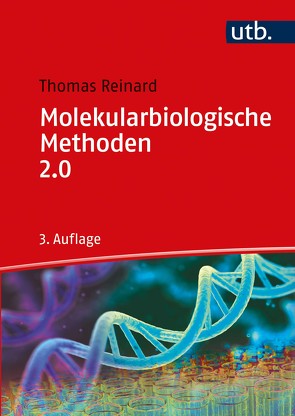
In den vergangenen Jahren hat sich die Molekularbiologie rasant weiterentwickelt. Technologien wie die Modulare Klonierung, PCR-basierte Klonierungen und das Gibson Assembly sind inzwischen in vielen Laboren als Standard etabliert. Neben den modernen Klonierungsverfahren wurden die die Denkansätze in der modernen Biologie revolutionierende Bioinformatik und die synthetische Biologie aufgenommen. Die zunehmende Bedeutung reicht inzwischen weit in die Gesellschaft hinein, wie die „Omics“-Technologien und die Genom Editierung zeigen, die ebenfalls in diesem Buch behandelt werden.
Die 3. Auflage wurde korrigiert und aktualisiert und enthält viele hilfreiche Tipps und Tricks, welche die Fehlersuche im Labor erleichtern können. Concept-Maps visualisieren Zusammenhänge zwischen den vorgestellten Methoden. Zahlreiche Abbildungen und Tabellen veranschaulichen komplexe Sachverhalte, „Gut zu wissen“-Boxen liefern Hintergrundinformationen, „Tipp“-Boxen geben wertvolle Hinweise für die praktische Arbeit und Protokolle besonders wichtiger Verfahren erleichtern das Verständnis.
Ideal für Studium und Praxis!
Aktualisiert: 2023-07-02
> findR *
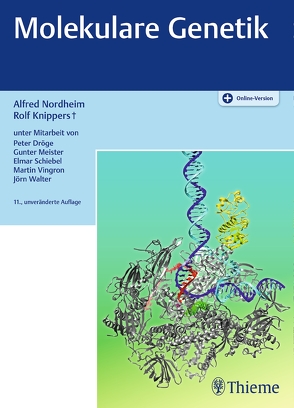
Vollständig und aktuell –molekulare Genetik für Ihr Studium.
Eine fundierte Kenntnis der molekularen Genetik gilt als Schlüsselqualifikation zum erfolgreichen Studium von Biologie und Medizin und deren speziellen Ausrichtungen wie z. B. Biochemie oder Molekularmedizin.
Dieser Klassiker bietet das gesamte aktuelle Grundwissen der molekularen Genetik. Er wurde für die 10. Auflage vollkommen überarbeitet und auf den neuesten Stand der Wissenschaft gebracht.
Die molekulargenetischen Prozesse werden an mikrobiellen und tierischen Systemen, inklusive des Menschen, dargestellt. Trotz der hohen Komplexität der Materie sind die Inhalte dieses Lehrbuches verständlich formuliert. Gut durchdachte Abbildungen in konsequentem Farbkonzept ergänzen die Texte optimal. "Zusatzinformationen" in separaten Boxen ermöglichen Ihnen den Blick über den "Tellerrand".
Jederzeit zugreifen: Die Inhalte dieses Buches können Sie sich online freischalten und sie dann mit allen gängigen Smartphones, Tablets und PCs nutzen.
Aktualisiert: 2023-06-28
> findR *
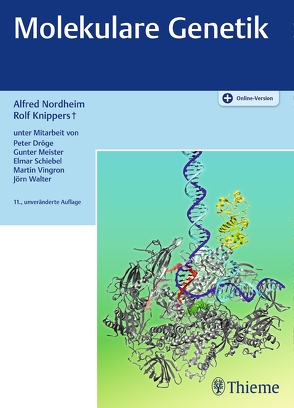
Vollständig und aktuell –molekulare Genetik für Ihr Studium.
Eine fundierte Kenntnis der molekularen Genetik gilt als Schlüsselqualifikation zum erfolgreichen Studium von Biologie und Medizin und deren speziellen Ausrichtungen wie z. B. Biochemie oder Molekularmedizin.
Dieser Klassiker bietet das gesamte aktuelle Grundwissen der molekularen Genetik. Er wurde für die 10. Auflage vollkommen überarbeitet und auf den neuesten Stand der Wissenschaft gebracht.
Die molekulargenetischen Prozesse werden an mikrobiellen und tierischen Systemen, inklusive des Menschen, dargestellt. Trotz der hohen Komplexität der Materie sind die Inhalte dieses Lehrbuches verständlich formuliert. Gut durchdachte Abbildungen in konsequentem Farbkonzept ergänzen die Texte optimal. "Zusatzinformationen" in separaten Boxen ermöglichen Ihnen den Blick über den "Tellerrand".
Jederzeit zugreifen: Die Inhalte dieses Buches können Sie sich online freischalten und sie dann mit allen gängigen Smartphones, Tablets und PCs nutzen.
Aktualisiert: 2023-06-28
> findR *
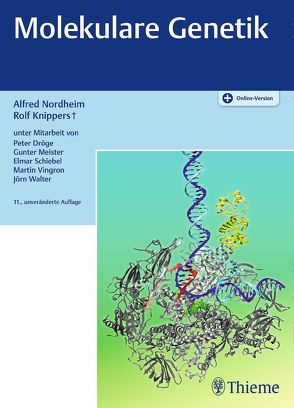
Vollständig und aktuell –molekulare Genetik für Ihr Studium.
Eine fundierte Kenntnis der molekularen Genetik gilt als Schlüsselqualifikation zum erfolgreichen Studium von Biologie und Medizin und deren speziellen Ausrichtungen wie z. B. Biochemie oder Molekularmedizin.
Dieser Klassiker bietet das gesamte aktuelle Grundwissen der molekularen Genetik. Er wurde für die 10. Auflage vollkommen überarbeitet und auf den neuesten Stand der Wissenschaft gebracht.
Die molekulargenetischen Prozesse werden an mikrobiellen und tierischen Systemen, inklusive des Menschen, dargestellt. Trotz der hohen Komplexität der Materie sind die Inhalte dieses Lehrbuches verständlich formuliert. Gut durchdachte Abbildungen in konsequentem Farbkonzept ergänzen die Texte optimal. "Zusatzinformationen" in separaten Boxen ermöglichen Ihnen den Blick über den "Tellerrand".
Jederzeit zugreifen: Die Inhalte dieses Buches können Sie sich online freischalten und sie dann mit allen gängigen Smartphones, Tablets und PCs nutzen.
Aktualisiert: 2023-06-28
> findR *
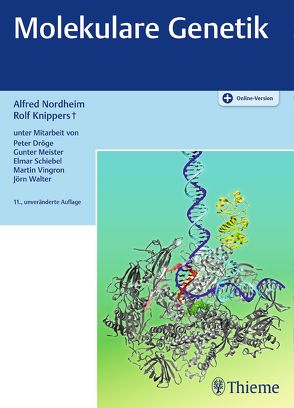
Vollständig und aktuell –molekulare Genetik für Ihr Studium.
Eine fundierte Kenntnis der molekularen Genetik gilt als Schlüsselqualifikation zum erfolgreichen Studium von Biologie und Medizin und deren speziellen Ausrichtungen wie z. B. Biochemie oder Molekularmedizin.
Dieser Klassiker bietet das gesamte aktuelle Grundwissen der molekularen Genetik. Er wurde für die 10. Auflage vollkommen überarbeitet und auf den neuesten Stand der Wissenschaft gebracht.
Die molekulargenetischen Prozesse werden an mikrobiellen und tierischen Systemen, inklusive des Menschen, dargestellt. Trotz der hohen Komplexität der Materie sind die Inhalte dieses Lehrbuches verständlich formuliert. Gut durchdachte Abbildungen in konsequentem Farbkonzept ergänzen die Texte optimal. "Zusatzinformationen" in separaten Boxen ermöglichen Ihnen den Blick über den "Tellerrand".
Jederzeit zugreifen: Die Inhalte dieses Buches können Sie sich online freischalten und sie dann mit allen gängigen Smartphones, Tablets und PCs nutzen.
Aktualisiert: 2023-06-28
> findR *
1.Einführung in das Thema2.Eigene molekularbiologische Untersuchungen. Material, Methoden und tierexperimentelle Ergebnisse3.Weitere Methodena) kompetitive Polymerase-Kettenreaktionb) Western-Blot4.Zusammenfassung5.Literatur
Aktualisiert: 2023-06-15
> findR *
1.Einführung in das Thema2.Eigene molekularbiologische Untersuchungen. Material, Methoden und tierexperimentelle Ergebnisse3.Weitere Methodena) kompetitive Polymerase-Kettenreaktionb) Western-Blot4.Zusammenfassung5.Literatur
Aktualisiert: 2023-06-07
> findR *
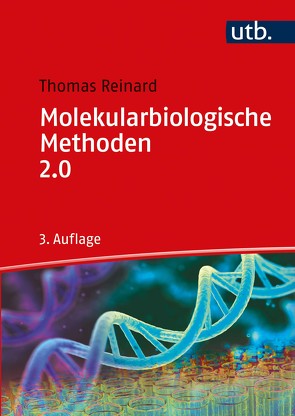
In den vergangenen Jahren hat sich die Molekularbiologie rasant weiterentwickelt. Technologien wie die Modulare Klonierung, PCR-basierte Klonierungen und das Gibson Assembly sind inzwischen in vielen Laboren als Standard etabliert. Neben den modernen Klonierungsverfahren wurden die die Denkansätze in der modernen Biologie revolutionierende Bioinformatik und die synthetische Biologie aufgenommen. Die zunehmende Bedeutung reicht inzwischen weit in die Gesellschaft hinein, wie die „Omics“-Technologien und die Genom Editierung zeigen, die ebenfalls in diesem Buch behandelt werden.
Die 3. Auflage wurde korrigiert und aktualisiert und enthält viele hilfreiche Tipps und Tricks, welche die Fehlersuche im Labor erleichtern können. Concept-Maps visualisieren Zusammenhänge zwischen den vorgestellten Methoden. Zahlreiche Abbildungen und Tabellen veranschaulichen komplexe Sachverhalte, „Gut zu wissen“-Boxen liefern Hintergrundinformationen, „Tipp“-Boxen geben wertvolle Hinweise für die praktische Arbeit und Protokolle besonders wichtiger Verfahren erleichtern das Verständnis.
Ideal für Studium und Praxis!
Aktualisiert: 2023-06-02
> findR *
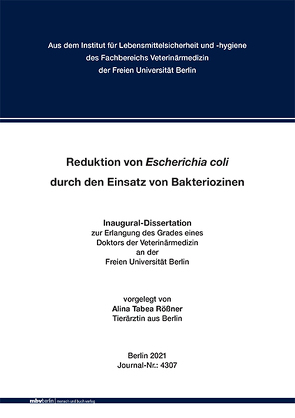
Reduction of Escherichia coli by bacteriocins
Contaminated food containing pathogenic microorganisms can lead to serious illnesses and pose a risk for consumers. Food of animal origin has a high transmission potential for food pathogens. Food-related pathogens such as Escherichia (E.) coli play an important role in causing food infections in humans. This has resulted in an increasing use of antibiotics which led to a higher rate of antibiotic resistance. Bacteriocins are antimicrobial proteins produced by bacteria. They are a promising alternative to antibiotics because they lyse their own or closely related species. They have no toxic effects on eukaryotic cells and are ubiquitous in the environment and therefore naturally present in food. Colicins and microcins, produced by E. coli, are a promising alternative to reduce pathogenic E. coli in food.
The aim of this study was to examine E. coli isolates from food samples for their ability to produce bacteriocins. The bacteriocin production was tested in a spot assay and the bacteriocin producers were then further characterized by PCR for the presence of known colicin and microcin genes. Furthermore, a phylogroup determination was carried out by PCR and the molecular weight of the bacteriocin extracts was determined by SDS-PAGE.
E. coli was isolated from different food matrices and 97,5 % of the isolates were confirmed by MALDI-TOF MS analysis. Most of the isolates (51,3 %) were found in meat samples. At least one reference strain was lysed bei 52,5 % of the E. coli isolates in the spot assay, in which the reference strain E. coli K-12 DH5 showed the highest sensitivity. The colicin genes B, E7 and Ia were the most frequently detected genes and the E. coli isolates were mainly assigned to phylogroups A (37,5 %) and B1 (36,3 %). Nine out of 33 protein extracts showed a lysis band between 55 and 75 kDa on the overlay agar of the incubated SDS-PAGE-gel.
After the detection of bacteriocin producers and characterization of the bacteriocins, a bacteriocin concentrate was produced. Tests were then carried out to determine whether this concentrate is able to reduce the reference strain E. coli K-12 DH5 defined conditions.
The concentrate was prepared from the overnight culture of the E. coli 2116 isolate. The isolate showed genes for the colicins E2 and K as well as for the microcin B17.
The E. coli 2116 overnight culture was filtered by tangential flow filtration at a cut off of 100 kDa and concentrated at a cut off of 30 kDa in order to obtain the colicin concentrate. After the immediate application of the E. coli 2116 colicin concentrate, the cell number of E. coli K-12 DH5 (107 CFU/ml) was reduced by six log units at 37°C and at 4°C. At 37°C, the cell number increased again within 24 h to 108 CFU/ml. At 4°C, the cell number remained constant at 101 CFU/ml for the entire test period. The usage of bacteriocins to reduce E. coli cell numbers in culture medium is possible at storage temperatures around 4°C. Using E. coli 2116 colicin concentrate in minced meat led to a reduction from one log unit till a reduction below the detection limit. The effect was dependent on the applied volume of the E. coli 2116 colicin concentrate. The more diluted the concentrate is being used, the fewer bacteriocins might be available. It is reasonable to assume that there might be interactions between bacteriocins and meat components. In future studies, different bacteriocin concentrates should be tested on various food matrices. Furthermore, their mechanisms and interactions with food matrices should be examined in detail.
Aktualisiert: 2022-05-05
> findR *
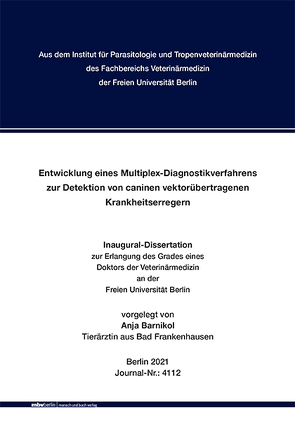
Die Weiterentwicklung von Diagnostikmethoden und die Generierung epidemiologischer Daten sind im Zusammenhang mit caninen vektorübertragenen Erkrankungen wichtige Voraussetzungen, um Infektionsrisiken einzuschätzen, geeignete Prophylaxe- und Therapiemaßnahmen zu ergreifen und somit die Verbreitung dieser Krankheitserreger einzudämmen. Im Rahmen dieser Arbeit wurde erstmals eine Triplex-PCR zur simultanen Detektion von caninen vektorübertragenen Erregern der Familie Onchocercidae sowie Anaplasmataceae und der Ordnung Piroplasmida entwickelt. Darauf aufbauend wurde mit der Etablierung einer Multiplex-Diagnostikmethode auf Basis der Luminex®-xMAP®-Technologie begonnen. Diese sollte zur Speziesdifferenzierung der Erreger dienen, die mit der Multiplex-PCR nachgewiesen wurden. In diesem Projekt lag der Fokus auf der Differenzierung der caninen Pathogene Babesia canis, Babesia vogeli, Babesia gibsoni, Anaplasma phagocytophilum, Ehrlichia canis, Candidatus Neoehrlichia mikurensis, Rickettsia conorii und Dirofilaria immitis. Der Versuch die Triplex-PCR mit einem zusätzlichen Primerpaar zum Nachweis von Rickettsia spp. auf ein Quadruplex-Verfahren zu erweitern, wurde abgebrochen, da die Methode im Vergleich zur Triplex-PCR weniger zuverlässige Ergebnisse liefern konnte. Im Rahmen der Entwicklung der genannten Diagnostikmethoden wurden 246 Blutproben von Hunden aus den Ländern Ungarn, Griechenland, Mazedonien, Bosnien-Herzegowina und Israel gesammelt und zum vereinfachten Transport sowie zur Konservierung auf FTA®-Karten archiviert. Zur Probengewinnung wurden Länder gewählt, in denen die ausgewählten Erreger endemisch sind. Die Beprobung wurde vor Ort bei Hunden durchgeführt, bei denen der Verdacht auf eine Infektion mit einem der hier relevanten Krankheitserreger bestand. Mittels eines DNAExtraktionsverfahrens wurden die Nukleinsäuren aus der Matrix des FTA®-Papiers isoliert und mit der Triplex-PCR sowie teilweise mit der Quadruplex-PCR untersucht. Aufgrund der Diskrepanz zwischen den Ergebnissen der beiden Verfahren sowie der scheinbar geringeren Sensitivität und Spezifität der Quadruplex-PCR im Vergleich zur Triplex-PCR wurde die Quadruplex-PCR ausschließlich bei 204 der 246 Proben angewandt. Die Blutproben aus Israel waren ausschließlich zur Verwendung im Etablierungsprozess der Diagnostikverfahren vorgesehen, da sie von Hunden stammten, die zum Beprobungszeitpunkt bereits mit vektorübertragenen Erkrankungen diagnostiziert waren.
Das speziesspezifische Multiplex-Diagnostikverfahren auf Basis der Luminex®-xMAP®-Technologie konnte in dem gegebenen Zeitrahmen nicht vollständig etabliert werden. Nach Durchführung einiger Modifikationen hinsichtlich der Kopplungs- und Hybridisierungsverfahren, wäre jedoch ein sensitiver und spezifischer Nachweis der hier ausgewählten Pathogene sowie eine Erweiterung des Assays auf weitere Erreger, basierend auf der beschriebenen Triplex-PCR, möglich.
Aktualisiert: 2021-09-30
> findR *
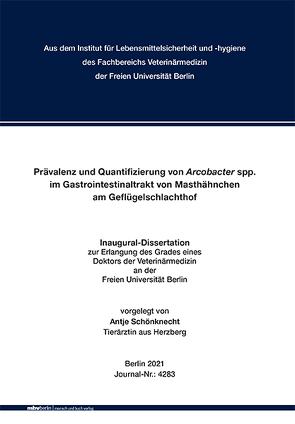
Prevalence and quantification of Arcobacter spp. in the intestinal tract of broiler chicken at the slaughterhouse
Arcobacter spp. are frequently detected in foods of animal origin, particularly in meat products. However, the source of Arcobacter contamination of chicken meat products are under debate.
Different studies concerning the prevalence of Arcobacter spp. in the intestinal content of broiler chicken determined contradictory results. Therefore, in the present study four different parts of the intestines were examined at five significant processing steps during chicken slaughtering in an abattoir. In total, 157 intestinal tracts originating from 19 different broiler chicken flocks were investigated qualitatively and semiquantitatively by selective enrichment.
Further species verification was conducted applying mPCR and rpoB-sequencing. After the first two processing steps, Arcobacter spp. was only sporadically detected in the intestinal contents after bleeding (2/32) and not detected after scalding (0/32). After defeathering, Arcobacter spp. were detected in 62 % (18/29) of the intestinal tracts. The prevalences ranged between 28 % (8/29) in the duodenal, 21 % (6/29) in the jejunal, 3 % (1/29) in the caecal and 55 % (16/29) in the rectal contents with loads of ≥ 24,000 MPN/g in the rectal contents.
Furthermore, Arcobacter spp. were detected in 88 % (7/8) of the rectal tissue samples. The prevalences and loads of Arcobacter spp. in the intestinal contents after evisceration are comparable to those after defeathering. The data determined in the present study indicate that detection of Arcobacter spp. in the intestinal contents of broiler chicken carcasses is highly probable after defeathering and after evisceration. Furthermore, the prevalences and loads with Arcobacter spp. in the duodenal and jejunal contents as well as in the rectal tissue samples suggest a possible reservoir of Arcobacter spp. inside the broiler chicken. Specific colonization trials might provide important data concerning the role of broiler chicken as reservoir for Arcobacter spp. In addition, the possibility of cross-contamination with Arcobacter spp. originating from the environment inside the slaughterhouse need to be considered. In the process of broiler chicken slaughter examined in this study, the defeathering step appears to be of importance concerning cross-contamination with Arcobacter spp. The mechanical pressure released on the carcasses during the defeathering process needs to be investigated in detail concerning a possible reflux of the intestinal contents towards the duodenum and jejunum. Additionally, epidemiological studies are necessary to identify the source of crosscontamination with Arcobacter spp. in the chicken slaughterhouse.
The potential pathogenicity of the species A. butzleri and A. cryaerophilus together with the high prevalences of these species in chicken meat and the possible transmission via consumption of contaminated chicken meat highlight the necessity to identify the source of cross-contamination with Arcobacter spp. and their transmission route into the chicken slaughterhouse.
Aktualisiert: 2022-01-20
> findR *
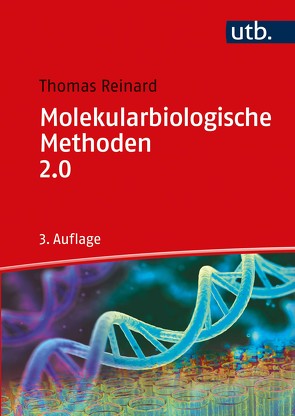
In den vergangenen Jahren hat sich die Molekularbiologie rasant weiterentwickelt. Technologien wie die Modulare Klonierung, PCR-basierte Klonierungen und das Gibson Assembly sind inzwischen in vielen Laboren als Standard etabliert. Neben den modernen Klonierungsverfahren wurden die die Denkansätze in der modernen Biologie revolutionierende Bioinformatik und die synthetische Biologie aufgenommen. Die zunehmende Bedeutung reicht inzwischen weit in die Gesellschaft hinein, wie die „Omics“-Technologien und die Genom Editierung zeigen, die ebenfalls in diesem Buch behandelt werden.
Die 3. Auflage wurde korrigiert und aktualisiert und enthält viele hilfreiche Tipps und Tricks, welche die Fehlersuche im Labor erleichtern können. Concept-Maps visualisieren Zusammenhänge zwischen den vorgestellten Methoden. Zahlreiche Abbildungen und Tabellen veranschaulichen komplexe Sachverhalte, „Gut zu wissen“-Boxen liefern Hintergrundinformationen, „Tipp“-Boxen geben wertvolle Hinweise für die praktische Arbeit und Protokolle besonders wichtiger Verfahren erleichtern das Verständnis.
Ideal für Studium und Praxis!
Aktualisiert: 2023-05-02
> findR *
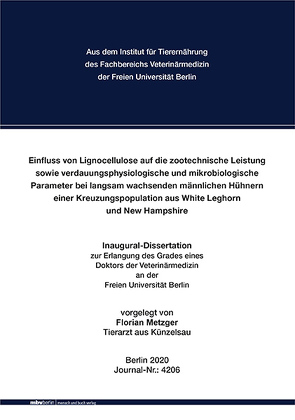
The use of dietary lignocellulose in poultry has been described in only few studies and with inconsistent effects on animal performance, nutrient digestibility and the composition of the intestinal microbiota. The aim of this study was to investigate the influence of higher dosages of dietary lignocellulose in isoenergetically and isonitrogenically designed diets on zootechnical, digestive and microbiological parameters. For this purpose, 59 male chickens of a slow-growing poultry cross-breeding population (WL77 - White Leghorn and NHI - New Hampshire) were divided into three experimental groups and were fed a diet containing 0.8, 5 and 10 % lignocellulose (ARBOCEL® RC Fine) over a period of eight weeks. The feeding trial was divided into a 5-week adaptation phase and a 23-day trial phase. Feed and water were continuously available ad libitum.
Zootechnical parameters were recorded weekly and digesta samples from ileum and caecum were taken in the 13th week. Additionally, excrements were collected daily over the last 12 days of the experimental period. The resulting data included not only the determination of the apparent precaecal digestibility of crude protein and the apparent total digestibility of crude fat and organic matter, but also analyses of bacterial metabolites and the composition and metabolic activity of selected bacterial clusters. Statistical evaluation of the results was performed by means of single factor analysis of variance or the Kruskal-Wallis test.
An influence of the diets used on the performance of the animals could not be determined. Neither the live mass, live mass gain, feed consumption nor feed expenditure showed changes between the experimental groups. The apparent precaecal digestibility of the crude protein was significantly decreased with 10 % supplemented lignocellulose compared to the experimental group with 0.8 and 5 %. The values of the apparent total digestibility of crude fat showed no changes with increasing contents of lignocellulose in the ration. Significant differences between all three experimental groups were documented in the apparent total digestibility of the organic mass. This parameter decreased with increasing supplements of lignocellulose in the diet. There were no group differences between dry matter contents of the excrements observed. A comparison of the bacterial metabolites in the caecal digesta showed a decrease of the analysed concentrations with increasing content of dietary lignocellulose.
The most significant changes in concentration were observed in the experimental group with 10 % lignocellulose. Significant effects on the composition and metabolic activity of the bacterial microbiota were detected in the quantification of the Escherichia/Hafnia/Shigella cluster. With increasing concentration of lignocellulose the measured cell numbers in the caecal digesta decreased. The also decreased values of the determined rRNA copies described a directed trend and additionally indicated a reduced metabolic activity.
In conclusion, the results of the present study show that higher concentrations of lignocellulose can influence the apparent precaecal digestibility of protein, the microbial metabolites in the digesta and the composition and activity of the bacterial microbiome. In addition, lignocellulose could have an impact on potential pathogens in the intestine, which should be investigated in further studies.
Aktualisiert: 2022-12-31
> findR *
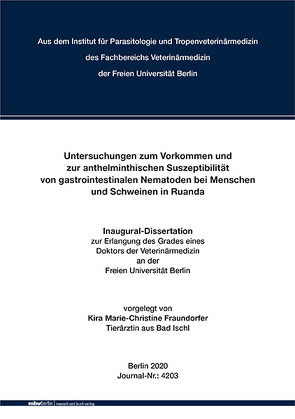
Soil transmitted helminths (STHs), namely Ascaris lumbricoides, Trichuris trichiura and the hookworms A. duodenale and N. americanus are common parasites in almost two billion humans globally and pose a great threat to human health, especially in schoolchildren. Strategic treatment against STHs becomes increasingly important in many endemic countries. School children are particularly vulnerable and STHs can inhibit school performance or, in more severe cases, lead to malnutrition and growth stunting. In Rwanda, preventive chemotherapy is applied once or twice a year to school children and most members of the target group are regularly treated.
In this present study, stool samples from school children aged six to ten years belonging to twelve schools and stool samples from pigs from the subdistricts of the southern province of Rwanda were examined using Mini-FLOTAC chamber to detect eggs of one or multiple of the STH species mentioned above. Fecal egg count reduction (FECR) and cure rate (CR) were calculated to assess whether worm populations in Rwanda showed any signs for development of resistance against benzimidazoles. In 2014, almost 2000 stool samples were examined. During the follow-up in the next year, additional 400 samples from four out of the twelve schools were collected and examined. Children which had been enrolled in the study brought a fresh stool sample to school, which was then collected. In 2014, the children were also clinically examined. Additionally, a blood sample was taken and finally the children were treated with Albendazol under supervision. A follow-up stool sample was collected seven to ten days after the first treatment. The same procedure was undertaken in 2015 but children were not again clinically examined nor had to provide a blood sample. In 2014, additional stool samples from pigs, living in sheds next to the house as the participating children, were collected and examined for eggs of Ascaris suum, Trichuris suis or gastrointestinal strongyles. For further investigations, samples were kept from which DNA was extracted in the laboratory in Berlin and molecular analysis of β-tubulin single nucleotide polymorphisms in Ascaris sp. was performed.
The overall prevalence for Ascaris sp. before the first round of deworming was 40 %, it decreased to 13 % after treatment. The results of microscopy in the present study showed signs of reduced efficacy of the BZ albendazole in nine out of 10 examined schools. The FECR in the affected schools was significally below the treshold suggested by Vercruysse et al. (2011). Overall it ranged from zero to 99.56 %. The CRs ranged from 33 to 100 %. However, the molecular biological results were not in line with the microscopic results since in none of the analyzed samples SNPs associated with BZ resistance were found.
The prevalence of Ascaris sp. in pigs ranged from 18,5 - 80,8 %, of T. suis from 0 - 28,8 % and prevalences of hookworm ranged from 72,2 – 94,2 %. In the as urban claimed villages of Ngoma and Tumba there were no pigs living at the time our study was conducted.
The results of the study suggest that resistance might have developed in the southern province of Rwanda and treatment has to be adapted accordingly to prevent further selection of resistant worm populations. This should be a priority in future prevention programs.
For better evaluation of the prevalence of resistant population, further research needs to be conducted throughout the entire country. As this study has failed to show any of the suggested SNPs associated with benzimidazole resistance, further investigations into the mechanisms of resistance in Ascaris sp. are suggested since it is possible that SNPs are found at other sites of the genome such as in additional β-tubulin isotypes. In addition, it is possible that BZ metabolism leads to resistance by reducing the concentration of active drug with the worms. Future research will be needed to identify the BZ resistance mechanisms in Ascaris sp.
Aktualisiert: 2022-12-31
> findR *
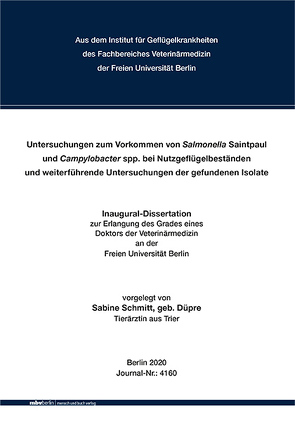
"Investigations on the occurence of Salmonella Saintpaul and Campylobacter spp. in poultry stocks and further investigations of the detected isolates"
The aim of this study was the evaluation of the samples, which were sent to the Institut für Geflügelkrankheiten of the Freie Universität Berlin from 2008 – 2011 because of statutory Salmonella investigation of poultry flocks. Further investigations were done with isolated Salmonella Saintpaul, which are one of the most often isolated serovars in turkeys. In 2013, S. Saintpaul has been the most often isolated serovar in fattening turkeys in the EU.
Also in this study, it was the most often isolated serovar in fattening turkeys from 2008 to 2010. In 2011 it was at 4th place after S. Infantis, S. Coeln and S. Typhimurium. S. Saintpaul can be a human pathogen and is frequently isolated from poultry meat samples, which is why we took a closer look at this serovar.
For further discrimation of the isolates a pulsed-field-gel-electrophoresis (PFGE) protocol was established. A total of 74 S. Saintpaul isolates were examined by PFGE, of which 67 isoaltes originated from fattening turkeys and seven from laying hens. Moreover 62 of the 74 isolates were tested for antimicrobial resistance. The resistance profiles were also used for discrimination. They widely matched with manual and computer analysis of the PFGE patterns.
Isolates matched from 35 – 100%, at which matching was higher the shorter the time between the sampling periods was.. Furthermore, there was a very high matching inbetween isolates from day-old-chicks over a timespan of four weeks, which were isolated from several flocks in Germany. This is most likely linked to the same origin of the chicks from the same breeder herds or via horizontal transmission at the hatchery. Unfortunately, the origin of the chicks in this study was unknown. We also found a very high match of isolates from day-oldchicks and laying hens. This indicates a common source of infection (i.e. wild birds, trucks, flock visitors, feed, etc.), what will not be solved without further investigation.
Another aim of this study was the attempt to isolate Campylobacter spp. from the samples sent to us due to statutory Salmonella investigation of poultry stocks. Till now there is no statutory provision for diagnosis of Campylobacter spp. in poultry stocks so we further investigated the method used in this study by other procedures.
First we performed isolation like in ISO 10727/2006 described, but instead of 10 ml of the Salmonella-preenrichement we only used 1 ml to not disturb the Salmonella diagnostics. We only found a prevalence of 18,1% in fattening turkeys and 9,4% in chickens. In fattening turkeys considerably more C. jejuni than C. coli were isolated, whereas in laying hens, it was more C. coli. This correlates to what was reported in the published literature. The very low prevalence instead contradicts the literature, why the isolation method was further checked.
Therefore we established a qantitative multiplex Realtime-Polymerase chain reaction (Multiplex qPCR). We investigated retained samples of the Salmonella preenrichement for the existence of Campylobacter-DNA. Here in 58,9% of the turkey samples and 96,3% of the laying hen samples Campylobacter-DNA was found. This is correlates to the literature.
It was noticed that the isolation results were worse the warmer the outside temperature had been. So we conducted storage trials to simulate the usual postal transportation of the Salmonella samples. Therefore, in the first trial we stored two different types of boot swabs for 30 Minutes, one day, two days, three days, four days and five days at different temperatures. Those swabs were scaled right after sampling and before testing to determine the weight loss. This weight loss was equalized with fluid loss. The weight loss unsurprisingly was higher the warmer the outside temperatures had been. We took a second standardized trial where we contaminated fecal samples of a negative laying hen flock with Campylobacter colonies and put the same amount of feces we found in trial one on the boot swabs. The swabs were again stored and investigated like in trial one.
The trials showed that the postal transportation is really disadvantageous for the isolation of Campylobacter spp. because of the oxidative stress for the bacteria, especially at high outside temperatures. A cooled transport to the laboratory is mandatory. If the cooling chain can be maintained the transportation can also endure longer than one day without compromising the isolation outcome.
Overall the isolation of Campylobacter spp. from the sent samples is not suitable for routine diagnostics. The Multiplex qPCR could be a reasonable alternative because of the rapidness of the method and the very low detection limit of Campylobacter-DNA. In addition in this study we further discriminated 54 C. jejuni isolates via sequencing of the Short Variable Region of the Flagellin A Gene (flaA-SVR). This showed a host specific as well as geographic relatedness. There was no time related relation.
Aktualisiert: 2022-12-31
> findR *
MEHR ANZEIGEN
Bücher zum Thema POLYMERASE-KETTENREAKTION
Sie suchen ein Buch über POLYMERASE-KETTENREAKTION? Bei Buch findr finden Sie eine große Auswahl Bücher zum
Thema POLYMERASE-KETTENREAKTION. Entdecken Sie neue Bücher oder Klassiker für Sie selbst oder zum Verschenken. Buch findr
hat zahlreiche Bücher zum Thema POLYMERASE-KETTENREAKTION im Sortiment. Nehmen Sie sich Zeit zum Stöbern und finden Sie das
passende Buch für Ihr Lesevergnügen. Stöbern Sie durch unser Angebot und finden Sie aus unserer großen Auswahl das
Buch, das Ihnen zusagt. Bei Buch findr finden Sie Romane, Ratgeber, wissenschaftliche und populärwissenschaftliche
Bücher uvm. Bestellen Sie Ihr Buch zum Thema POLYMERASE-KETTENREAKTION einfach online und lassen Sie es sich bequem nach
Hause schicken. Wir wünschen Ihnen schöne und entspannte Lesemomente mit Ihrem Buch.
POLYMERASE-KETTENREAKTION - Große Auswahl Bücher bei Buch findr
Bei uns finden Sie Bücher beliebter Autoren, Neuerscheinungen, Bestseller genauso wie alte Schätze. Bücher zum
Thema POLYMERASE-KETTENREAKTION, die Ihre Fantasie anregen und Bücher, die Sie weiterbilden und Ihnen wissenschaftliche
Fakten vermitteln. Ganz nach Ihrem Geschmack ist das passende Buch für Sie dabei. Finden Sie eine große Auswahl
Bücher verschiedenster Genres, Verlage, Autoren bei Buchfindr:
Sie haben viele Möglichkeiten bei Buch findr die passenden Bücher für Ihr Lesevergnügen zu entdecken. Nutzen Sie
unsere Suchfunktionen, um zu stöbern und für Sie interessante Bücher in den unterschiedlichen Genres und Kategorien
zu finden. Unter POLYMERASE-KETTENREAKTION und weitere Themen und Kategorien finden Sie schnell und einfach eine Auflistung
thematisch passender Bücher. Probieren Sie es aus, legen Sie jetzt los! Ihrem Lesevergnügen steht nichts im Wege.
Nutzen Sie die Vorteile Ihre Bücher online zu kaufen und bekommen Sie die bestellten Bücher schnell und bequem
zugestellt. Nehmen Sie sich die Zeit, online die Bücher Ihrer Wahl anzulesen, Buchempfehlungen und Rezensionen zu
studieren, Informationen zu Autoren zu lesen. Viel Spaß beim Lesen wünscht Ihnen das Team von Buchfindr.
